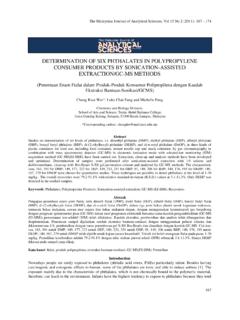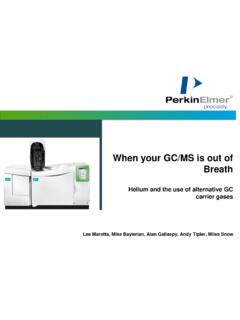Transcription of Determination of PBB and PBDE in polymers by GC …
1 62321 IEC:2008 59 Annex A (informative) Determination of PBB and pbde in polymers by GC-MS Introductory remark This annex specifies a gas chromatography - mass spectrometry (GC-MS) test method for the Determination of monobrominated to decabrominated biphenyls (PBB) and monobrominated to decabrominated diphenyl ethers ( pbde ) in polymers of electrotechnical products having PBB and pbde contents in the range of 100 mg/kg to 2 000 mg/kg and as high as 100 000 mg/kg for decaBDE. This test method has been evaluated for PS-HI (polystyrene, high-impact), (PC+ABS) (a blend of polycarbonate and acrylonitrile butadiene styrene) and ABS (acrylonitrile butadiene styrene). The use of this method for other types or concentration ranges outside those specified above has not been evaluated.
2 PBB and pbde compounds are determined using Soxhlet extraction of the polymers with separation by gas chromatography - mass spectrometry (GC-MS) qualitatively and quantitatively using single (or selected ) ion monitoring (SIM). Apparatus, equipment and materials Apparatus The following items shall be used for the analysis: a) Analytical balance capable of measuring accurately to 0,000 1 g. b) 1 ml, 5 ml, 10 ml, 100 ml volumetric flasks. c) Soxhlet extractors: 30 ml Soxhlet extractors; 100 ml round-bottomed flask; ground-in stopper NS 29/32; Dimroth condenser NS 29/32; boiling stones ( glass pearls or Raschig rings). d) Extraction thimble (cellulose, 30 ml, ID 22 mm, height 80 mm). e) Glass wool (for extraction thimble).
3 F) Deactivated injector liner (for GC-MS). g) Heating jackets. h) Funnel. i) Aluminium foil. j) Cork rings. k) Microlitre syringe or automatic pipettes. l) Pasteur pipette. m) 1,5 ml sample vials with 100 l glass insert and a screw cap with polytetrafluoroethylene (PTFE) gasket or, depending on the analytical system, a comparable sample receptacle. n) Mini-shaker (also known as vortexer or vortex mixer). 60 62321 IEC:2008 Equipment A gas chromatograph with a capillary column coupled to a mass spectrometric detector (electron ionization, EI) is used for the analysis. The mass spectrometric detector shall be able to perform selective ion monitoring and have an upper mass range of at least 1 000 m/z.
4 The high-range mass is required to unambiguously identify decaBDE and nonaBDE. The use of an autosampler is strongly recommended to ensure repeatability. A column length of approximately 15 m has sufficient separation efficiency for PBB and pbde compounds. Reagents All chemicals shall be tested for contamination and blank values prior to application. a) Toluene (GC grade or higher). b) Helium (purity of greater than 99,999 % (v/v)). c) Technical BDE-209 with BDE-209 ~ 96,9 % and BDE-206 ~ 1,5 % solution. d) PBB and pbde calibrants (see Clause ). e) Surrogate and internal standards: Surrogate standard used to monitor analyte recovery according to , , , and Clause , DBOFB (4, 4 -dibromoctafluorobiphenyl) (n) or 13C-labelled pentaBDE or octaBDE standard.
5 Internal standard used to correct for injection errors, according to , , , and Clause , CB209 (2,2 ,3,3 ,4,4 ,5,5 ,6,6 -decachlorobiphenyl). NOTE 1 The standards are acceptable when using a quadrupole-type mass spectrometer. A high-resolution mass spectrometer will require the use of other suitable standard substances having a mass and elution time similar to that of the analyte. 13C-labelled nonaBDE and 13C-labelled decaBDE are recommended for the high- mass PBDEs. NOTE 2 The standards suggested are adequate for measuring the concentrations of mono- through octaBDE. Due to their low mass and high volatility, these standards may be inadequate for measuring decaBDE and nonaBDE concentrations. By far the best calibration standard for these specific analytes would be 13C-labelled decaBDE or one of the 13C-labelled nonaBDEs.
6 Some laboratories, operating on the principal of high volume/low price, may find these labelled materials too expensive for their business plan. A potential low-cost substitute is decaBB (BB 209). BB 209 has a high mass (943,1 g/mol vs. 959,1g/mol for decaBDE or 864,2 g/mol for nonaBDE), which elutes just before the three nonaBDEs on a typical DB-5 column. The presence of significant quantities of decaBB in the sample itself can readily be determined by monitoring the peak area of this standard, and comparing it to what is expected from the added quantity of decaBB. The use of the suggested labelled standards or decaBB should be limited to those analyses where the only analytes of interest are decaBDE and/or the nonaBDEs.
7 With additional experimentation it may be possible to identify alternate standards that have the high mass and low volatility necessary for the quantification of the nonaBDEs and decaBDE. General instructions for the analysis The following general instructions shall be followed: a) In order to reduce blank values, ensure the cleanliness of all glass equipment (excluding volumetric flasks) and deactivate glass wool ( ) at 450 C for at least 30 min. To avoid decomposition (debromination) of PBDEs by UV light during extraction and analysis, glass equipment made from brown glass shall be used, if possible. If no brown glass is available, aluminium foil can be used for protection from light. b) If the amount of Br determined by XRF is considerably above the 0,1 % range, it will be necessary to carry out the analysis using an adjusted sample size or by repeating the analysis using an extract that has been appropriately diluted prior to internal standard addition.
8 62321 IEC:2008 61 Sample preparation The samples shall be ground to pass through a 500 m sieve before extraction. Cryogenic grinding with LN2 cooling is strongly recommended. Stock solutions The following stock solutions shall be prepared: a) Surrogate standard (to monitor analyte recovery): 50 g/ml in toluene ( ) ( DBOFB). b) Internal standard (to correct for injection error): 10 g/ml in toluene ( ) ( CB209). c) Polybrominated biphenyl (PBB) solution: 50 g/ml in an organic solvent. d) Polybrominated diphenyl ether ( pbde ) solution: 50 g/ml in an organic solvent. e) Matrix spiking solution: Containing a total of 4 calibration congener standards in toluene ( ) or other appropriate solvent (see ) as indicated in Table Table Matrix spiking solution Bromination Number of pbde congeners Number of PBB congeners Mono to penta 1 1 Hexa- to deca- 1 1 The addition of 1 ml of a matrix spiking solution containing each of the four congeners in a concentration of 10 g/ml is suitable for delivery of the required 10 g (see ) in the matrix spike sample.
9 Pre-extraction of the Soxhlet extractors To clean the Soxhlet extractors ( ), a 2 h pre-extraction is carried out with 70 ml of the appropriate solvent (see ). The washing solvent is discarded. Sample extraction The following steps shall be followed for sample extraction: a) Transfer 100 mg 10 mg of the sample into the extraction thimbles ( ). Record the mass to the nearest 0,1 mg. Toluene ( a) shall be used as the extraction solvent. b) The sample is transferred through a funnel ( ) into the extraction thimble ( ). In order to ensure a quantitative transfer, the funnel ( ) is rinsed with approximately 10 ml of solvent. c) 200 l of the surrogate standard ( ) (50 g/ml) is added (in accordance with ). d) In order to prevent the sample from floating, the thimble ( ) is closed with glass wool ( ).
10 Approximately 60 ml of solvent is placed in the 100 ml round-bottomed flask ( ), the equipment is covered with aluminium foil ( ) to exclude light and the sample is extracted for at least 2 h with each cycle being approximately 2 min to 3 min. Shorter extraction times may result in lower recoveries of the analytes, particularly the higher molecular mass PBDEs. e) The extract is placed in a 100 ml volumetric flask and the round-bottomed flask ( ) is rinsed with approximately 5 ml of solvent. NOTE If the solution exhibits turbidity due to the matrix, this can be reduced by adding 1 ml of methanol. The difference between the density of methanol and toluene ( ) can be disregarded in this case in the calculation.






